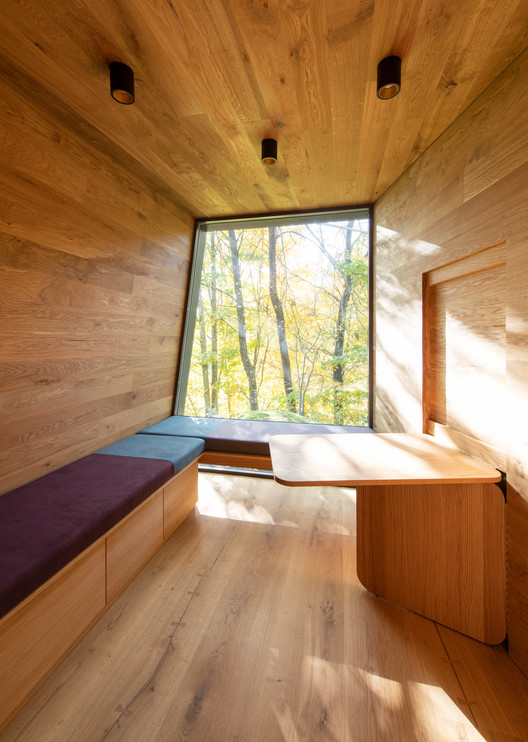AD Classics Wohnhaus Schlesisches Tor (Bonjour Tristesse) Álvaro Siza Vieira + Peter Brinkert
2014-06-25 01:00
在1980年委托,Bonjour Tristesse是为1987年柏林国际建筑展览会设计的众多项目之一。彼得·艾森曼、阿尔多·罗西、詹姆斯·斯特林和阿尔瓦罗·西扎等建筑师被邀请为战后柏林的重建做出贡献。展览的项目将以温和的城市更新和关键重建为重点。
Commissioned in 1980, Bonjour Tristesse was one of the many projects designed for the International Building Exhibition Berlin of 1987. Architects such as Peter Eisenman, Aldo Rossi, James Sterling, and Álvaro Siza were invited to contribute to the rebuilding of a post-war Berlin. The projects for the exhibition were to be designed with a focus on gentle urban renewal and critical reconstruction.
Siza的住房项目位于Kreuz berg区,在19世纪的一个街区的拐角处。由于原来的角楼在战争中被摧毁,两边的建筑物之间留下了一个巨大的空隙。战争结束后,建造了一系列单层零售店,但这种解决方案不符合周围建筑物的高度,也没有提供任何急需的住宅。1980年,零售商店被拆除,以便为新的Bonjour Tristesse让路。
Siza’s housing project is situated in the Kreuzberg district, at the corner of a 19th century block. As the original corner building was destroyed in the war, a large void was left between the buildings on each side. Following the war, a series of single-story retail stores was constructed, however this solution did not match the heights of the surrounding buildings and did not provide any residences which were badly needed. In 1980 the retail stores were demolished in order to make way for the new Bonjour Tristesse.
Project site before construction. Image © Flickr user Hen's March
项目工地施工前。图片c Flickr用户Hen的游行
七层结构强烈地展示了西扎作品的语境性,以其对环境的敏感性而闻名。该设计最突出的特点是其连续的、弯曲的立面连接相邻的建筑物,有效地完成了街区的角落。这种雕塑姿态在建筑物的后面也通过一条小凹形曲线得到了回响。其形态的另一个特征是屋顶向拐角的微妙上升。灰色外观被密集而规则的窗口所穿透,反映了周围建筑的典型秩序和节奏。
The seven-story structure strongly exhibits the contextual nature of Siza’s work, which is well-known for its sensitivity to surroundings. The most prominent characteristic of the design is its continuous, curving façade that joins the adjacent buildings and effectively completes the corner of the block. This sculptural gesture is echoed at the rear of the building as well by a small concave curve. Another feature of its morphology is the subtle rising of the roofline towards the corner. The grey exterior is penetrated by a dense and regular grid of windows, reflecting the typical order and rhythm of surrounding buildings.
在上下文中,Bonjour Tristesse社会住房项目在视觉上显得有趣和矛盾。虽然刚性窗口图案意在与周围环境融为一体,但曲线形式却是对德国表现主义的一种借鉴,因此与其周围环境形成了鲜明的对比。正是这种并置为结构提供了一个极其独特的外观。[1]
In context, the Bonjour Tristesse social housing project appears visually intriguing and contradictory. While the rigid window pattern is meant to blend in with its surroundings, the curvilinear form is intended to be a reference to German Expressionism, and thus contrasts with its surroundings. It is this juxtaposition that provides the structure with an extremely unique appearance. [1]
Bonjour Tristesse大厦是一座混合用途的建筑,地面层的商业功能和六层以上的住宅。早期的设计方案包括24套单元和4层楼梯,但为了更好地满足克鲁兹堡对住房的迫切需求,这一设计方案被修改为46套和2层。
A mixed-use building, Bonjour Tristesse houses commercial functions at ground level and residential on the six floors above. An early design proposal included 24 units and 4 stairs, however, this was revised to 46 units and 2 stairs in order to better meet the urgent need for housing in Kreuzberg.
这个项目被称为Bonjour Tristesse(法语中的“你好悲伤”),因为它在1980年代末出现在正面最上面的部分上。Siza并不特别喜欢涂鸦,他本来想把它移走,但后来他意识到在选定的区域上画画会使它更加突出,而且整个外墙在经济上是不可能的,于是他决定把它拿走。[2]
The project became known as Bonjour Tristesse (“hello sadness”in French) for the graffiti marking that appeared on the uppermost portion of the facade in the late 1980s. Siza, who is not particularly fond of graffiti, had originally wanted it removed but decided to leave it after he realized that painting over the select area would make it more prominent and that painting the entire façade was not financially possible. [2]
© Flickr user jaime.silva
在柏林的复兴是必要的时期,Bonjour Tristesse作为一个微妙的,但引人注目的贡献城市战后身份。柏林的社会住房项目是他在葡萄牙以外的第一个项目,增加了他的国际知名度,并导致了全球项目的增加。西扎以他在城市环境中整合项目的能力而闻名于世,后来他获得了1992年普利茨克奖。
Built during a time when the regeneration of Berlin was necessary, Bonjour Tristesse serves as a subtle yet striking contribution to the city’s post-war identity. The social housing project in Berlin, being his first project outside of Portugal, increased his international recognition and led to an increase of global projects. Siza, who is well-known for his ability to integrate projects in an urban context, later won the 1992 Pritzker Prize.
资料来源:[1]Leoni,G.lvaro Vieira(米兰:Motta,2009年)。[2]Winant,P.Street Art:Faces-Moving With the Times(蠕虫,德国:Renolit SE)。
Sources: [1] Leoni, G. Álvaro Vieira (Milan: Motta, 2009). [2] Winant, P. Street Art: Facades – Moving with the Times (Worms, Germany: Renolit SE).
建筑师lvaro Siza Vieira,Peter Brinkert Location Schlesische Stra e 8,10997柏林,德国类别社会住房建筑师,负责lvaro Siza Vieira项目年1984年通过维基百科公域拍摄照片,Flickr用户Hen‘s三月,Flickr用户Humberto Marum,Flickr用户lortnoc
Architects Álvaro Siza Vieira, Peter Brinkert Location Schlesische Straße 8, 10997 Berlin, Germany Category Social Housing Architect in Charge Álvaro Siza Vieira Project Year 1984 Photographs via Wikipedia Commons, Flickr user Hen's March, Flickr user Humberto Marum, Flickr user lortnoc
 举报
举报
别默默的看了,快登录帮我评论一下吧!:)
注册
登录
更多评论
相关文章
-

描边风设计中,最容易犯的8种问题分析
2018年走过了四分之一,LOGO设计趋势也清晰了LOGO设计
-

描边风设计中,最容易犯的8种问题分析
2018年走过了四分之一,LOGO设计趋势也清晰了LOGO设计
-

描边风设计中,最容易犯的8种问题分析
2018年走过了四分之一,LOGO设计趋势也清晰了LOGO设计




















































